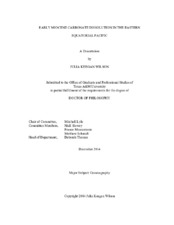| dc.description.abstract | As the world’s largest ocean, the Pacific Ocean is intrinsically linked to the major changes in current and past climate via several mechanisms, in particular, through the carbon cycle’s influence on atmospheric CO2 concentrations. One way to understand the ocean carbon cycle is to study fluctuations in the CaCO3 content of ocean sediments and determine the nature, timing, and drivers of those events. As part of a larger effort to reconstruct Cenozoic paleoclimate in the eastern equatorial Pacific, XRF records are used here to define an early Miocene low CaCO3 event in the equatorial Pacific that corresponds to the seismic horizon termed “Lavender”. The low CaCO3 interval is correlated at submeter scale in 4 drill sites from IODP Expedition 320/321 and has been identified by seismic reflection throughout the region, indicating a large perturbation in the global carbon cycle at the time of its deposition. Using multi-element XRF data, we have determined that this event was caused by CaCO3 dissolution, with peak dissolution occurring at 16.9 Ma. The event begins prior to the Miocene Climate Optimum (MCO) with peak dissolution coinciding with the initial warming step of the MCO. Three potential disrupters of CaCO3 deposition are investigated: a change in organic carbon burial to the deep ocean, reducing deep dissolved inorganic carbon (DIC); a change in mantle CO2 outgassing associated with the formation and emplacement of the Columbia River basalt province; and basin-basin fractionation, where development of a new CaCO3 depocenter in the Atlantic reduces CaCO3 deposition in the Pacific. Of these 3 possibilities, the timing of the Lavender event favors basin-basin fractionation. | en |


